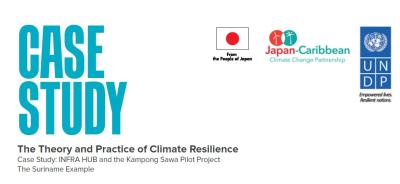Suriname is located on the north-eastern coast of South America bordering French Guiana in the east, Brazil in the south, Guyana in the west, and the Atlantic Ocean in the north. The northern, lowland coastal area is particularly vulnerable to inundation and erosion of coastal zones and other negative impacts of climate change. Some of the proposed adaptation measures include: integrated coastal zone management, the efficient utilization of water resources, and the development of salt-tolerant crops.
Suriname’s climate is semi-humid, influenced by the behavior of the Inter Tropical Convergence Zone (ITCZ). The mean annual air temperature in Suriname is 27 degrees Celsius. Two rainy and two dry seasons occur annually. Suriname receives between 1500mm and 2500mm of rainfall each year. Suriname’s coastal zone is very fertile. 90 per cent of Suriname’s human activities such as agriculture and small industries are located here, along with a large share of the population. Coastal zones also include highly important ecosystems for the breeding and feeding of various species. The tropical rainforest in Suriname is one of the important natural resources, covering approximately 91 per cent or 15 million hectares of the total land area, of which about 2 million hectares or 13% has the status of Protected Areas.
The industrial base of Suriname is dominated by the mining and petroleum industries. To a lesser extent, the agricultural and tourism sectors also contribute to the country’s Gross Domestic Product (GDP). The vast majority of these industries are concentrated in coastal zones. Large-scale inundation associated with climate change could adversely affect these industries.
Reference: First National Communication 2005
Latest Publications
See allOn the coastline of Suriname, Kampong Sawa residents are suffering the impacts of rising sea levels. This case study documents a pilot project…


